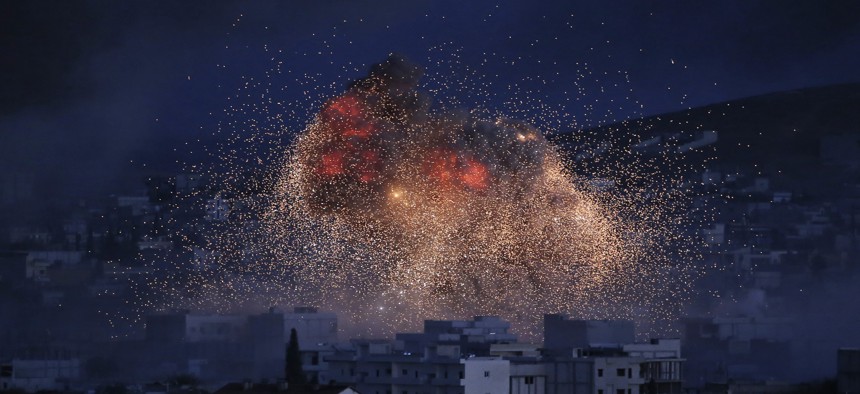
Thick smoke and flames from an airstrike by the U.S.-led coalition rise in Kobani, Syria, as seen from a hilltop on the outskirts of Suruc, at the Turkey-Syria border, Monday, Oct. 20, 2014. Vadim Ghirda/AP
Obama Needs an ISIS War Czar Before It’s Too Late
Obama’s ISIS fight looks more like Iraq in 2003 than in 2007, when military and civilian leaders were synced hip-to-hip.
With the Islamic State, or ISIS, still entrenched across a large swath of Iraq and Syria after a year of U.S.-led airstrikes, the Obama administration is under growing criticism for devoting insufficient resources to the war. Several experts now call for the U.S. to send additional trainers and advisers, under less restrictive rules of engagement, to support the Iraqi Security Forces and Kurdish Peshmerga, and to intensify efforts to build a moderate Syrian rebel force.
These steps are essential, but also inadequate. While the fight against ISIS is under-resourced, it suffers from two equally grave failings: a disjointed command structure that makes civil-military unity of effort all but impossible, and the absence of an integrated campaign plan to defeat the enemy. Until both of these problems are tackled, more troops and weapons are unlikely by themselves to turn the tide.
If there is one lesson our post-9/11 experience in Iraq and Afghanistan should have taught us, it is that these conflicts are neither strictly military nor strictly political. Progress in them therefore requires what the U.S. did during the 2007-2008 surge in Iraq, when Gen. David Petraeus and Amb. Ryan Crocker worked together, fused at the hip, under a campaign plan that their teams jointly developed and that weaved together security and diplomatic lines of effort into a coherent whole.
The opposite of this approach is what ensued during the Bush administration’s disastrous first year in Iraq, when the slapdash Coalition Provisional Authority and an equally slapdash military headquarters stumbled from crisis to crisis, largely disconnected from each other, without a campaign plan.
Right now, the Obama administration’s approach to ISIS looks more like 2003 than 2007.
To begin with, consider the fragmented military architecture of the ISIS fight. For the past year, the strike campaign over Syria and Iraq has been run out of a three-star headquarters in Kuwait that was never intended to run a war of this scope or duration. Even more importantly, because the headquarters is in Kuwait, the U.S. Embassy in Baghdad has been deprived of a day-to-day military partner on the Petraeus-Crocker model.
The Kuwait-based strike headquarters is also detached from the two-star command responsible for reconstituting Iraqi forces. And all of this, in turn, is disconnected from the U.S. effort to develop an anti-ISIS force among the Syrians, which U.S. Central Command’s Gen. Lloyd Austin told the Senate Wednesday, has resulted in “four or five” American-trained fighters currently inside of Syria.
The situation is equally fractured on the civilian side, where there is no single person or office accountable for developing and implementing a cohesive political strategy against ISIS. Instead, Obama has tapped a presidential special envoy for the anti-ISIS coalition, a deputy special envoy (who is also the deputy assistant secretary of state for Iraq and Iran), a U.S. ambassador in Baghdad, and a special envoy for Syria.
Then there is the issue of interagency coordination in Washington—the responsibility of the National Security Council. Only there doesn’t appear to be anyone at the NSC designated to do this in the anti-ISIS fight—no “war czar,” a position created by the Bush Administration during the surge.
Given this jumble, it should be no surprise—as Obama administration officials privately admit—that there is no civil-military campaign plan to defeat ISIS. Rather, the White House cites multiple “lines of efforts” against the Islamic State—which is a polite way of saying that the different parts of the U.S. bureaucracy are each doing their own thing.
ISIS, by contrast, is prosecuting a unified campaign on both sides of the Iraq-Syrian border. Despite being vastly weaker than the coalition, part of the reason for ISIS’s resilience is that its activities are coordinated and focused, whereas our conventional strength is being dissipated by the structural incoherence of our effort.
This problem is fixable but requires urgent action. First, Obama should establish a formal operational headquarters for the Iraq-Syria campaign and put it in Baghdad. Together with the U.S. embassy and the State Department’s Syria team, this headquarters should be tasked with developing a joint civil-military campaign plan against ISIS.
The good news is that the logical unit to serve as operational headquarters for the ISIS fight—the headquarters of the Army’s III Corps—is already sending 450 soldiers to Kuwait. But this is a mission that needs to be co-located with the U.S. Embassy in Iraq, not several hundred miles away.
Back in Washington, the White House should reestablish a “war czar” position at the National Security Council. The 'war czar' position would be distinct from Gen. John Allen's efforts to pull together the multinational coalition to support the anti-ISIS efforts. Congress can help by pressing the Obama administration not only on the need for more manpower and firepower against ISIS, but also on the lack of a civil-military campaign plan and a coherent architecture to prosecute this fight.
Eight years ago, then-Senator Obama excoriated the Bush administration’s mishandling of Afghanistan, which he characterized as the most important front in the global war on terror. At the time, the criticism had merit. In 2007, the war in Afghanistan was under-resourced, with a dysfunctional and disjointed command structure, and with no civil-military campaign plan in place to defeat the insurgency.
Today, absent a course change, that is precisely the trifecta that Obama himself is set to bequeath to the next president unless he makes immediate changes.